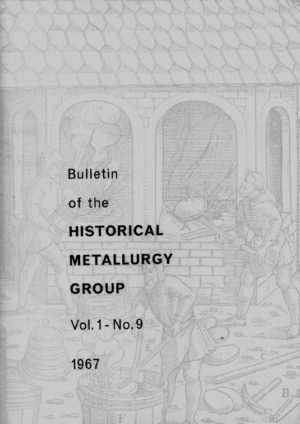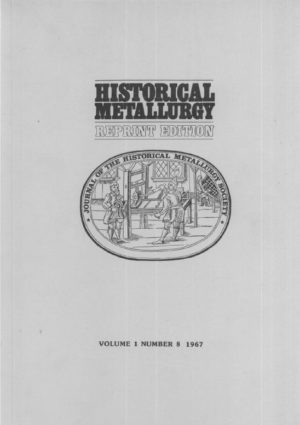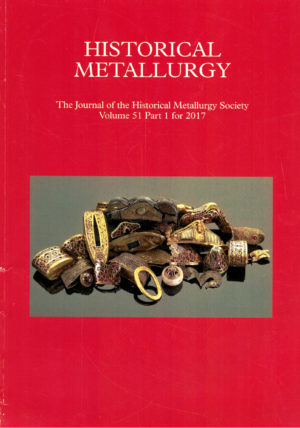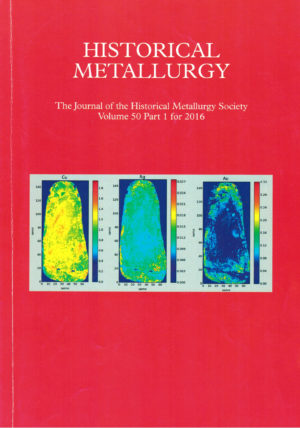Journal Contents
One hundred years of blast furnace development
R T Kingdon
Pages 63-76
The first successful smelting furnace in the north of England was the Backbarrow furnace operating at Fumess in 1712. This used the traditional reductant charcoal, however by 1720 when the average furnace in the UK produced 5.75 tons iron per week, many blast furnaces were changing to coal and by 1730, Abraham Darby at Coalbrookdale had successfully smelted iron with coke. The change to coke significantly increased output. In 1745 the Whitehill blast furnace at Pictree-on-Wear near Chester-le-Street, producing 25 tons per week of iron, became the first iron smelter in North Eastern England. Ironstone was brought from Robin Hood’s Bay and local coal was used.
A letter from Henry Bessemer. Regarding the continuous casting of steel products
John S Kebabian
Pages 77-80
H B Chess Esqr
Dear Sir
I have much pleasure in replying to the questions you ask in reference to the Rolling of fluid steel &c. As far back as the year 1856 my attention was directed to the facility which malleable iron in a fluid state afforded for producing castings in clay or metal moulds, and generally admitting of such treatment as had been found practicable with other fluid or semifluid materials. I therefore conceived the idea of producing tubes, rods, bars, wires, sheets &c. by forcing the metal through suitable openings direct from the fluid state but on full consideration of the subject numerous and apparently insurmountable difficulties presented themselves, and I soon abandoned all idea of producing tubes or rods after the manner of making endless lead pipe, but I became convinced that under proper arrangements it would be possible to Roll fluid metal between horizontal rollers into sheets, plates, or flat bars, for I had many years previous to the date of this invention succeeded in rolling lengths of plate glass between a pair of rolls placed side by side.
The study of early iron production in Spis
Lubomír Mihok, Peter Cengel, Alois Hollý and Frantisek Javorský
Pages 81-85
The Spis basin, situated in the North Slovakia east of the High Tatras and surrounded from the south side with the Slovak Ore Mountains, created favourable conditions for human settlement from the earliest times. Frequent archaeological findings reflect the development of human society in this region up to the Neolithic period. Much excavated material belongs to the Iron Age when a dominating factor was the production of iron and its fabrication to useful iron objects. Rich material from excavation sites around Spisska Nova Ves, has been submitted for metallurgical examination in cooperation with archaeologists. This contribution discusses the findings of these examinations on materials associated with the early production of iron in the La Tene and Early Roman periods from 300 B.C. to 200 A.D.
Phase changes associated with the hydrogen reduction conservation process for ferrous artifacts
P J Archer and BD Barker
Pages 86-91
Metallurgical examination of ferrous artefacts has revealed the presence of derived structures such as martensite and tempered martensites. Conservation of these artefacts by the hydrogen reduction technique, involves the application of elevated temperatures for up to 144 hours. This paper describes the effect of prolonged exposure at high temperatures on typical microstructures found in archaeological iron work, in particular, cutting implements such as swords, knives, etc
Photomicrographic examination of an early American iron
John White and Richard Jones
Pages 92-95
The Eaton (Hopewell) Furnace near Youngstown, Ohio represents the earliest American blast furnace yet found to have used charcoal and raw coal as a combinatory fuel in the production of iron. Built in 1802, it was the first blast furnace west of the Allegheny Mountains. Seven specimens of pig iron taken from various horizontal and stratigraphic areas of the site were submitted to photomicrographic examination. Analysis indicates that the Eaton ironworkers knew their business. Despite a “cold” furnace, they produced a strikingly clean direct metal equal essentially to modem iron. Indications are that earlier statements regarding the poor quality of limestone used as a flux may have been precipitous, the fact beiag that a self-fluxing ore may well have been utilized.
The origin of the blast fiornace: Evidence from Francophone areas
Brian G Awty
Pages 96-99
In their recent article on the origin of the blast furnace,’ Tholander and Blomgren call for a more critical approach to some of the evidence previously presented and suggest that many early references to cast iron cannot ‘with any certainty be connected with the blast furnace, because cast-iron was a normal by product of the high bloomery’. They follow J W Gilles in regarding some of the evidence given by Johannsen for 15th-century German furnaces as ‘not presented in a historically satisfactory way’ and in concluding that the transition from “Flossofen zum Hochofen” in Germany must have taken place during the 16th century. Early Swedish production of pig iron is similarly called in question by reference to the Osterby ironworks records (1551-1662), which show only small amounts of pig iron being produced up to 1580, ‘indicating the single “masugn” to have been of the high bloomery type’. They seem to accept that the blast furnace may have been introduced into central Poland from northern Italy soon after 1610, but in general favour a date between around 1580 and 1600 (cf. Gilles, ‘Um 1600 treten die ersten hohen Giessofen mit engem Gestell und offener Brust, die Holzkohlen-Hochofen, in Urkunden auf) for completion of the blast furnace’s evolution. In considering the literary evidence they point to the complete absence of references to the blast furnace and the conversion of pig into wrought iron in the works of Agricola and Biringuccio, the authors of the most famous books on 16th-century metallurgy. Apart from a highly controversial re-examination of Nicholas Bourbon’s poem Ferraria (1517), they ignore work on French language areas and on the British Isles (prior to the Philosophical Transactions illustration of a blast furnace (1678), and apart from a quotation from Gilles, that ‘in France the name “haut fourneau” for blast furnace appears first in the 18th century’).
This neglect of English and French experience is almost certainly a mistake. The Paimingridge furnace accounts of the 1540s are those of a furnace whose sole product was cast iron, whilst cast iron was being shipped on the central Meuse in many hundreds of tons a year by the 1550s. In the pays de Bray, the area of northern France from which the indirect process came to the Weald, the use of the Germanic word gueuse to describe the sows of iron produced by the blast furnace certainly points to a Germanic language area as the likely one for the first production of cast iron in Europe. But for all other elements of the indirect process the Walloon and French areas evolved their own terminology, which certainly has a very ancient origin. Indeed the drome-beam bellyhelve of the Walloon chafery was so French that in German speaking areas, as in England, the drosme of drome of this hammer assembly seems to have been known tautologically as a Tram-balken.
Metallurgical notes on exibits at the Royal Air Force Museum, RAF Cosford
William O Alexander
Pages 100-
The metallurgical information on the artifacts which were on display at R A F Cosford on the occasion of the History of Alloys Conference, 21st to 23rd September, 1984, is recorded below. The first section refers to some of the aeroplanes which were specifically highlighted and is followed by references to specific parts of the more famous aero engines made up to 1950.
![[Test] The Historical Metallurgy Society](https://test.historicalmetallurgy.org/wp-content/uploads/2020/02/Logo120.png)





There are no reviews yet.